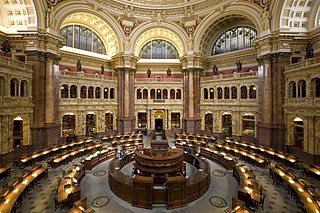Related Research Articles

The Smithsonian Institution, or simply the Smithsonian, is a group of museums, education and research centers, the largest such complex in the world, created by the U.S. government "for the increase and diffusion of knowledge." Founded on August 10, 1846, it operates as a trust instrumentality and is not formally a part of any of the three branches of the federal government. The institution is named after its founding donor, British scientist James Smithson. It was originally organized as the United States National Museum, but that name ceased to exist administratively in 1967.

The Internet Archive is an American nonprofit digital library founded on May 10, 1996, and chaired by free information advocate Brewster Kahle. It provides free access to collections of digitized materials including websites, software applications, music, audiovisual and print materials. The Archive also advocates for a free and open Internet. As of February 4, 2024, the Internet Archive holds more than 44 million print materials, 10.6 million videos, 1 million software programs, 15 million audio files, 4.8 million images, 255,000 concerts, and over 835 billion web pages in its Wayback Machine. Its mission is committing to provide "universal access to all knowledge".

JSTOR is a digital library of academic journals, books, and primary sources founded in 1994. Originally containing digitized back issues of academic journals, it now encompasses books and other primary sources as well as current issues of journals in the humanities and social sciences. It provides full-text searches of almost 2,000 journals. Most access is by subscription but some of the site is public domain, and open access content is available free of charge.

Digitization is the process of converting information into a digital format. The result is the representation of an object, image, sound, document, or signal obtained by generating a series of numbers that describe a discrete set of points or samples. The result is called digital representation or, more specifically, a digital image, for the object, and digital form, for the signal. In modern practice, the digitized data is in the form of binary numbers, which facilitates processing by digital computers and other operations, but digitizing simply means "the conversion of analog source material into a numerical format"; the decimal or any other number system can be used instead.

The National Museum of American History: Kenneth E. Behring Center collects, preserves, and displays the heritage of the United States in the areas of social, political, cultural, scientific, and military history. Among the items on display is the original Star-Spangled Banner. The museum is part of the Smithsonian Institution and located on the National Mall at 14th Street and Constitution Avenue NW in Washington, D.C.

The National Museum of Natural History (NMNH) is a natural history museum administered by the Smithsonian Institution, located on the National Mall in Washington, D.C., United States. It has free admission and is open 364 days a year. with 4.4 million visitors in 2023, it was the most-visited museum in the United States.

The Smithsonian American Art Museum is a museum in Washington, D.C., part of the Smithsonian Institution. Together with its branch museum, the Renwick Gallery, SAAM holds one of the world's largest and most inclusive collections of art, from the colonial period to the present, made in the United States. More than 7,000 artists are represented in the museum's collection. Most exhibitions are held in the museum's main building, the Old Patent Office Building, while craft-focused exhibitions are shown in the Renwick Gallery.

The Library of Virginia in Richmond, Virginia, is the library agency of the Commonwealth of Virginia. It serves as the archival agency and the reference library for Virginia's seat of government. The Library moved into a new building in 1997 and is located at 800 East Broad Street, two blocks from the Virginia State Capitol building. It was formerly known as the Virginia State Library and as the Virginia State Library and Archives.
Oral history preservation is the field that deals with the care and upkeep of oral history materials, whatever format they may be in. Oral history is a method of historical documentation, using interviews with living survivors of the time being investigated. Oral history often touches on topics scarcely touched on by written documents, and by doing so, fills in the gaps of records that make up early historical documents.

The Library of Congress (LOC) is a research library in Washington, D.C., that serves as the library and research service of the U.S. Congress and the de facto national library of the United States. Founded in 1800, the library is the United States's oldest federal cultural institution. The library is housed in three elaborate buildings on Capitol Hill. It also maintains a conservation center in Culpeper, Virginia. The library's functions are overseen by the Librarian of Congress, and its buildings are maintained by the Architect of the Capitol. The Library of Congress is one of the largest libraries in the world. Its collections contain approximately 173 million items, and it has more than 3,000 employees. Its "collections are universal, not limited by subject, format, or national boundary, and include research materials from all parts of the world and in more than 470 languages."

Smithsonian Libraries and Archives is an institutional archives and library system comprising 21 branch libraries serving the various Smithsonian Institution museums and research centers. The Libraries and Archives serve Smithsonian Institution staff as well as the scholarly community and general public with information and reference support. Its collections number nearly 3 million volumes including 50,000 rare books and manuscripts.

The Archives of American Art is the largest collection of primary resources documenting the history of the visual arts in the United States. More than 20 million items of original material are housed in the Archives' research centers in Washington, D.C., and New York City.

The UCL Centre for Digital Humanities is a cross-faculty research centre of University College London. It brings together digital humanities work being done in many of the university's different departments and centres, including the library services, museums and collections. The Centre counts among the "most visible" in the field and facilitates various opportunities for study at post-graduate level, including the MA/MSc in Digital Humanities, doctoral study, and short courses as part of the Department of Information Studies.

Transcribe Bentham is a crowdsourced manuscript transcription project, run by University College London's Bentham Project, in partnership with UCL Centre for Digital Humanities, UCL Library Services, UCL Learning and Media Services, the University of London Computer Centre, and the online community. Transcribe Bentham was launched under a twelve-month Arts and Humanities Research Council grant.

A Wikipedian in residence or Wikimedian in residence (WiR) is a Wikipedia editor, a Wikipedian, who accepts a placement with an institution, typically an art gallery, library, archive, museum, cultural institution, learned society, or institute of higher education to facilitate Wikipedia entries related to that institution's mission, encourage and assist it to release material under open licenses, and to develop the relationship between the host institution and the Wikimedia community. A Wikipedian in residence generally helps to coordinate Wikipedia-related outreach events between the GLAM and the general public such as editathons.

The Medical Heritage Library (MHL) is a digital curation collaborative among several medical libraries which promotes free and open access to quality historical resources in medicine. The MHL is currently digitizing books and journals and is working to expand to the digitization of archival materials and still images. In 2010, the MHL began digitizing titles, mainly monographs, in a variety of medical history and related fields including chemistry, nursing, dentistry, audiology, physiology, psychology, psychiatry, biological science, hydrotherapy, weather, veterinary medicine, gardening, physical culture, and alternative medicine chosen for their scholarly, educational, and research value. Since the inception of the project, materials in audio and video formats have been added to the collection.

The Digital Access to a Sky Century @ Harvard (DASCH) is a project to preserve and digitize images recorded on astronomical photographic plates created before astronomy became dominated by digital imaging. It is a major project of the Center for Astrophysics | Harvard & Smithsonian. Over 500,000 glass plates held by the Harvard College Observatory are to be digitized. The digital images will contribute to time domain astronomy, providing over a hundred years of data that may be compared to current observations.
The Venice Time Machine is a large international project launched by the École Polytechnique Fédérale de Lausanne (EPFL) and the Ca' Foscari University of Venice in 2012 that aims to build a collaborative multidimensional model of Venice by creating an open digital archive of the city's cultural heritage covering more than 1,000 years of evolution. The project aims to trace circulation of news, money, commercial goods, migration, artistic and architectural patterns amongst others to create a Big Data of the Past. Its fulfillment would represent the largest database ever created on Venetian documents. The project is an example of the new area of scholar activity that has emerged in the Digital Age: Digital Humanities.

Siobhan Leachman is a New Zealand citizen scientist, open knowledge advocate, and Wikimedian whose work focuses on natural history.
References
- ↑ "A night at the museum? Nah, but Smithsonian needs volunteers for digitization project". 14 August 2014. Retrieved 4 July 2015.
- 1 2 "Volunteers Needed for Massive Smithsonian Digitization Project". Smithsonian Institution. Retrieved 4 July 2015.
- 1 2 3 4 "About". Smithsonian Transcription Center. Smithsonian Institution. Retrieved 4 July 2015.
- ↑ Thompson, Helen. "The Smithsonian Wants You! (To Help Transcribe Its Collections)". Smithsonian.com. Smithsonian Institution. Retrieved 4 July 2015.
- ↑ Mazmanian, Adam. "Smithsonian transcription project moves out of beta". FWC The Business of Federal Technology. United States Government. Retrieved 4 July 2015.
- ↑ Crow, Kelly (11 September 2014). "The Smithsonian Works to Digitize Millions of Documents". The Wall Street Journal. The Wall Street Journal. Retrieved 4 July 2015.